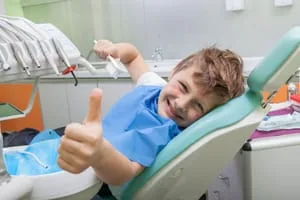Routine Cleaning Appointments

Before or after a professional cleaning, Dr. Carla will thoroughly examine your child’s teeth and gums for signs of tooth decay, gum disease, and other health problems. She may also want to take x-rays which will allow her to see dental issues not visible to the naked eye.
The practice uses advanced digital x-ray technology which saves time, provides clearer dental images, and exposes patients to less radiation than with traditional x-ray technology.
A fluoride treatment may be applied which helps preventing cavities by coating teeth and preventing plaque from building up and hardening on the tooth's surface.
RESTORATIONS
Sealants
A sealant is a protective coating that is applied to the chewing surfaces (grooves) of the back teeth (premolars and molars), where four out of five cavities in children are found. This sealant acts as a barrier to food, plaque and acid, thus protecting the decay-prone areas of the teeth.
|
|
|
Composite restorations
Composite (white) dental fillings, or resin restoratives, are used to repair a tooth that is affected by decay, fractures, or wear. After decay is removed, the tooth will be cleaned and the filling will then be placed to restore your child’s tooth to its original shape and function.
Crowns/Nerve Treatments
If your child’s tooth has extensive decay, or has been damaged by trauma, crowns are used to save this tooth until the permanent tooth can erupt and take its place. A primary tooth can be restored with either a stainless steel or white porcelain crown during one appointment.
If decay is large enough that it has extended into the pulp (nerve) of the primary tooth or trauma has exposed the nerve of the tooth, pulp therapy may be recommended.
Pulp therapy is often referred to as a "nerve treatment", "children's root canal", "pulpectomy" or "pulpotomy". The two common forms of pulp therapy in children's teeth are the pulpotomy and pulpectomy. A pulpotomy removes the diseased pulp tissue within the crown portion of the tooth. A pulpectomy is required when the entire pulp is involved (into the root canals of the tooth). During this treatment, the diseased pulp tissue is completely removed from both the crown and root. The tooth is cleansed, disinfected and, in the case of primary teeth, filled with a resorbable material. Nerve treatments are followed by a final restoration which is usually a stainless steel or white porcelain crown.
If your child was given local anesthetic to numb the treatment area, it is very important for you to monitor your child closely for approximately four hours following the appointment. It is often wise to keep your child on a liquid or soft diet until the anesthetic has worn off. Often, children do not understand the effects of local anesthesia, and may chew, scratch, suck, or play with the numb lip, tongue, or cheek. These actions can cause minor irritations or they can be severe enough to cause swelling and abrasions to the tissue.
EXTRACTIONS

Although it is best to try to save all primary teeth, it may be necessary to remove a tooth due to decay, trauma, or crowding/orthodontic reasons.
After extractions:
- Do not scratch, chew, suck, or rub the lips, tongue, or cheek while they feel numb or asleep. The child should be watched closely so he/she does not injure his/her lip, tongue, or cheek before the anesthesia wears off for approximately 4 hours.
- Do not rinse the mouth, use mouth wash, or drink through a straw for several days in avoid disrupting the clot formed after the extraction.
- Do not drink a carbonated beverage (Coke, Sprite, etc.) for the remainder of the day.
- Keep fingers and tongue away from the extraction area.
Some bleeding is to be expected. If unusual or sustained bleeding occurs, place cotton gauze firmly over the extraction area and bite down or hold in place for fifteen minutes. This can also be accomplished with a tea bag. Repeat if necessary.
- Maintain a soft diet for a day or two, or until the child feels comfortable eating normally again.
- Avoid strenuous exercise or physical activity for several hours after the extraction.
For discomfort use Children’s Tylenol, Advil, or Motrin as directed for the age of the child. If a medicine was prescribed, then follow the directions on the bottle. Please do not hesitate to call the office if there are any questions.
Space Maintainers
Space maintenance is necessary to prevent future space loss and hold space for the permanent tooth that erupts after a primary tooth. Without the use of a space maintainer, teeth can shift and can block out the permanent tooth’s eruption. When this happens, there may be an increased need for orthodontic treatment (braces) in the future.
SEDATION DENTISTRY
Nitrous Oxide
Nitrous oxide, or laughing gas, is a frequently used method for children with mild to moderate anxiety. A small mask will be placed on your child’s nose and your child will be asked to breathe through his or her nose. If your child is able to follow these instructions, he or she will become relaxed but will still be awake and able to talk with Dr. Carla and the assistants. At the end of your child’s appointment, he or she will resume breathing regular oxygen, and all the effects of nitrous oxide will disappear.
In-Office IV Sedation
If your child has severe anxiety or multiple areas of decay requiring extensive treatment, in-office IV sedation may be a better alternative. A Board Certified Pediatric Anesthesiologist will provide a medication to lightly sedate your child while sitting on his/her parent’s lap. Once it takes effect, the child is moved to into the dental chair and the anesthesiologist will administer medicine though an intravenous injection to further sedate your child. Any necessary x-rays will be taken prior to starting dental treatment in order to complete all work in one visit while the child is sedated. After Dr. Carla completes all the dental treatment, your child wakes up with a nurse and parent in the room. They have no memory of the treatment.
More information about Pediatric Dental Anesthesiology Associates (PDAA) can be found at: http://pediatricsedation.com/


